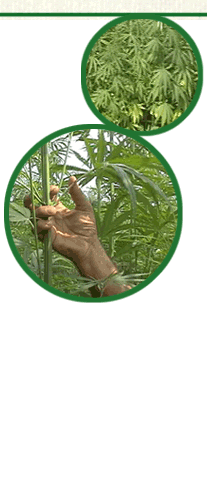
| |
Implementation of sustainable production systems |
Traditional cultivation of fibre hemp has all but disappeared from developed countries and only in some of the Asian and Eastern European countries is it still grown on a modest area, thanks only to the low cost of hand-labour. In Europe only a few thousand hectares of hemp are cultivated, most of which is destined for the production of paper, insulation material, animal bedding, eco-building materials, and seed-oil.
Today hemp and other fibre crops are only a niche market in Europe. To re-launch the cultivation of hemp and other fibre crops Gruppo Fibranova has studied sustainable production systems that respect the environment and enable existing farmers to perform the primary processing steps, and thus profit from it. Mechanised harvesters and industrial hackling and retting processes have all been revised and adapted for an actual production situation. |
Production and commercialisation of seeds |
Those interested in cultivating hemp should use the variety that is adapted to the given environment and the intended end-use of the hemp. The necessary choices should be made in advance in order to give sufficient time for seeds of a suitable variety to be provided. Having said this though there are currently still some difficulties in seed reproduction and there is a scarcity of genotypes adapted to Italian environment. In response to this Gruppo Fibranova is committed to the multiplication and commercialisation of seeds from both National and International sources in order to guarantee secure seed availability. The primary objective of the Group is the commercialisation of seeds that have been selected and improved with respect to specific growing conditions and end-uses of the plant (textile fibres, paper pulp, oilseeds for food and non-food use).
Starting from the agronomic year 2005-2006, seeds of six hemp varieties will be available: Fibranova, Red Petiole, Tiborszallasi and Chameleon. |
| |
Hemp cultivation in a modern agricultural system |
Hemp disappeared from Italian crop rotation systems many years ago. Its reintroduction must therefore follow the principles of modern agriculture. The agro-techniques must be re-thought so that they respect the on-farm and environmental conditions of today, and they must be assessed according to the needs of each actor along the production chain. It is via the chosen agro-techniques that the qualitative characteristics of the raw materials can be controlled. Also the agro-techniques must be modified with respect to the environment and the end-use of the fibre.
The technicians of Gruppo Fibranova will support farmers in selecting the hemp variety most adapted to their needs and will offer qualified technical support throughout the growing season, from choosing the sowing time until choosing the time and method of harvesting. |
| |
Mechanisation of the Harvest and its Logistics |
In modern day agriculture the use of machinery is almost unavoidable in the sense that the use of mechanical harvesters enables large areas of hemp crop to be cut and treated within a short time after plant maturity (i.e. after the end of flowering). Machinery also assists the efficient preparation and storage of the hemp prior to its scutching (which may be done several months after the harvest). In the case of linen the harvesters and bailers have evolved in time and today exist flax pullers, single and double swath revolvers, and fast and efficient specially designed round bailers. Hemp on the other hand has been left with the Russian reapers and binders that are still in use in Eastern European countries. Gruppo Fibranova has therefore verified that the machines designed for linen can be utilised for scutching the hemp bundles. Though possible it requires the hemp stems to be reduced in length to a minimum of 90 cm and a maximum of 110 cm. Having been reduced in length the hemp fibre can then also be combed in the linen weaving industries. Gruppo Fibranova have therefore chosen to cut the hemp stems to the required length at the time of harvest, such that the subsequent steps as followed for linen, (laying cut stems in swaths, turning and bailing), can also be used for hemp. |
|
|

| 
|



![]()
